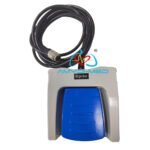Jan. 17 , 2019
(1) The patient is over-moving and too turbulent, so that the blood oxygen saturation parameter of Compatible Sensor Extension Cable cannot find a pulse form;
(2) The patient may be perfused too low, such as the limb temperature is too low, the peripheral circulation is too poor, so that the oxygen saturation parameter can not measure the blood oxygen saturation and pulse rate;
(3) The Sensor Extension Cable is damaged;
(4) The position of the sensor is not accurate (the connector line should be placed on the back of the hand and the nail face is facing up);
(5) There are stains (such as methylene blue, fluorescein) in the blood, skin coloring or nail polish on the fingernails, which will also affect the measurement accuracy;
(6) There is a strong light source in the environment. If the surgical light, fluorescent light or other direct light causes the acceptance value of the photosensitive element of the probe to deviate from the normal range, it is necessary to avoid strong light. The probe should be shaded if necessary;
(7) After the probe is worn for a long time, it may affect the blood circulation and affect the measurement accuracy;
(8) In addition, when the blood pressure is measured by the ipsilateral arm, the peripheral circulation is affected and the measured value is inaccurate.



